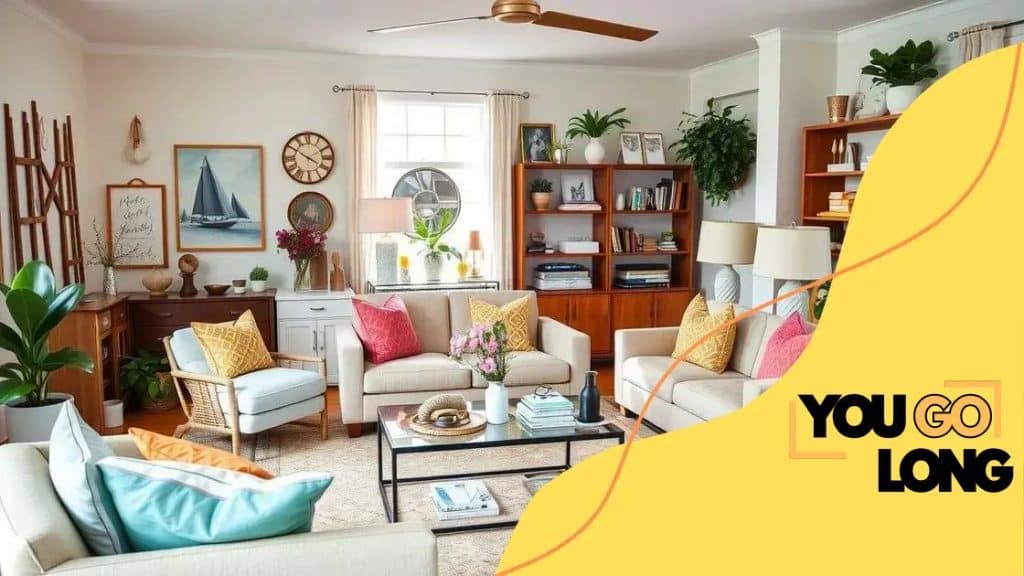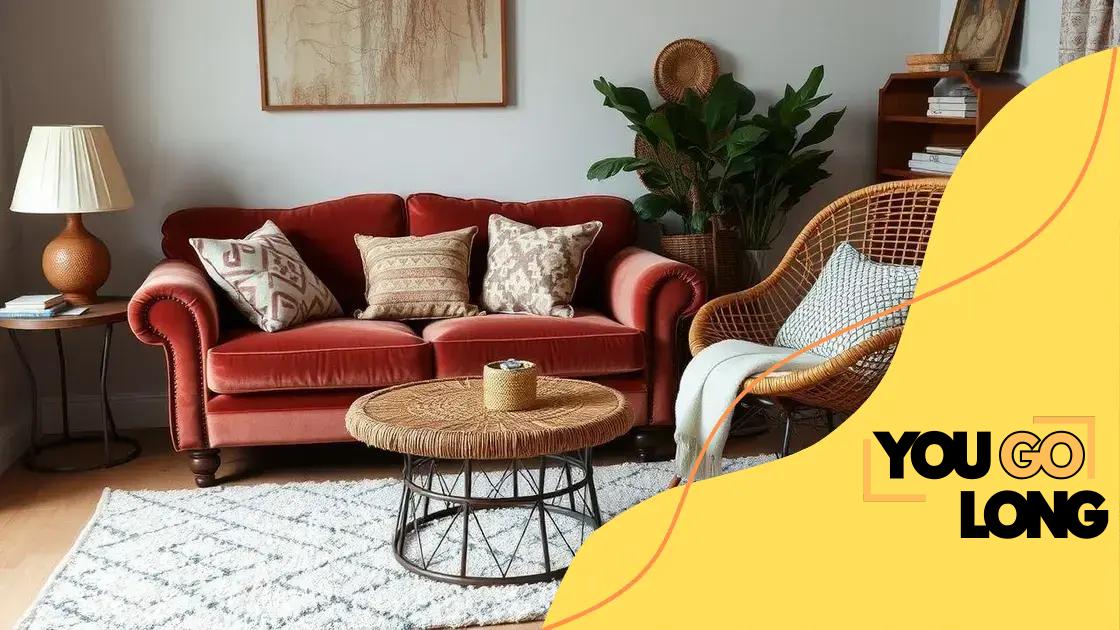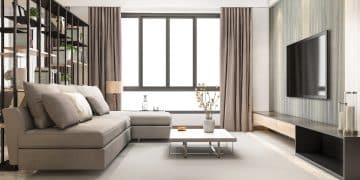Essential home decor items to enhance your space

Advertisement
Incorporating personal touches to your decor enhances your space, reflecting your unique style through meaningful items, artwork, textiles, and plants that create a warm and inviting atmosphere.
Essential home decor items to enhance your space can truly transform how you feel in your environment. Whether through a splash of color or unique decor pieces, every choice counts. Ready to create your dream space?
Choosing the right color palette
Choosing the right color palette is essential for creating a harmonious space in your home. Colors can affect mood and perception, so selecting the perfect combination can significantly enhance your environment.
Understanding Color Psychology
Every color has a unique effect on our emotions. For example, blues can evoke feelings of calm, while yellows can create a sense of cheerfulness. Understanding color psychology can help you choose shades that resonate with the atmosphere you want to create.
Advertisement
Techniques for Selecting Colors
Start by considering the purpose of each room. For instance, soft, neutral tones are often best for bedrooms, while vibrant splashes of color work well in playrooms. Here are some techniques to help you:
- Consider the room’s lighting.
- Use a color wheel for complementary colors.
- Test samples on your walls.
- Think about the mood you want to set.
Additionally, look for inspiration in nature or artwork you love. These elements can provide a natural guide for what colors work well together. One effective method is to start with a statement piece and build your palette around that.
Creating Balance
Once you have selected your colors, it’s crucial to create balance within the space. Avoid overwhelming a room with too many bold colors. Instead, incorporate accent colors with furniture or accessories to maintain a cohesive look. Keeping 60% of your room in a dominant color, 30% in a secondary color, and 10% as an accent color is a useful rule of thumb.
Advertisement
In conclusion, knowing how to choose the right color palette can transform the feel of your home. By understanding color psychology, using practical techniques, and maintaining balance, you’ll create a beautiful and inviting space.
Utilizing natural light effectively
Utilizing natural light effectively can transform your living spaces, making them feel larger and more inviting. Light not only brightens a room but also enhances the overall mood and atmosphere.
Understanding Window Placement
The placement of windows in your home plays a significant role in natural light accessibility. Larger windows can flood a room with sunlight. Consider using floor-to-ceiling windows in areas where you want to maximize light exposure.
Choosing the Right Window Treatments
Your choice of window treatments can either enhance or block natural light. Here are a few options to consider:
- Sheer curtains allow light while offering privacy.
- Blinds can be adjusted to control brightness.
- Use light colors to reflect more sunlight.
- Consider removing heavy drapes to open up the space.
When selecting window treatments, always keep in mind the quality and amount of light you want in each room. This can change the look and feel of your space dramatically. Using mirrors can also help reflect light throughout the room, making it feel brighter.
Placement of Furniture
Another way to effectively utilize natural light is through strategic furniture placement. Avoid blocking windows with large furniture pieces. Instead, arrange your furniture to create an open layout that encourages light flow. Sofas and chairs can be angled to face windows, maximizing the light coming in.
By incorporating plants near windows, you not only enhance the decor but also promote a vibrant atmosphere. Plants thrive in natural light, adding life to your rooms. Moreover, the gentle shadows created by sunlight can add depth to the decor.
Incorporating textures and fabrics

Incorporating textures and fabrics into your home decor can elevate your space and add depth to your design. Different materials bring unique feelings and visual interest to any room.
Understanding Textures
Textures can be tactile or visual, creating layers in your decor. For example, a plush rug can provide warmth underfoot, while a sleek coffee table adds a modern touch. Mixing various textures creates contrast that captivates the eye.
Choosing the Right Fabrics
When selecting fabrics, consider their function. Soft fabrics like cotton and linen are perfect for cozy spaces, while more durable materials like leather work well in high-traffic areas. Here are some popular fabrics to consider:
- Velvet for luxury and softness.
- Jute or sisal for natural textures.
- Silk for elegance and sophistication.
- Canvas for durability and a casual look.
Layering different fabrics can also enhance the warmth and comfort of your decor. Think of combining plush throw pillows with a soft blanket on your sofa. These elements invite people to sit, relax, and enjoy the space.
Pattern Play
Incorporating patterns into your textiles can create visual interest. Mixing floral, geometric, and striped patterns adds complexity and charm. However, it’s essential to balance these patterns with solid colors to avoid overwhelming the space. Begin with a few patterned accent pieces to see how they blend with your existing decor.
Using textures and fabrics creatively can also reflect your personal style. Incorporate wall hangings made of macramé, or use a variety of cushions to express your taste. Keeping textures varied but coordinated contributes to a cohesive look.
Selecting furniture that fits your style
Selecting furniture that fits your style is crucial for creating a comfortable and cohesive space. The right pieces not only enhance the beauty of your home but also reflect your personality.
Identifying Your Style
Before you start shopping, take a moment to identify your preferred decorating style. Do you lean toward modern, traditional, bohemian, or minimalistic designs? Understanding your taste will guide your choices and make the process easier.
Setting a Budget
Budgeting is an important step in selecting furniture. Here are some tips to help you stay on track:
- Determine the maximum amount you’re willing to spend.
- Prioritize essential pieces like sofas and beds.
- Consider investing in timeless items that will last.
- Look for sales and discounts to maximize your budget.
Staying within budget allows you to plan for other decor elements like textiles and accessories, which are equally important for enhancing your space.
Choosing Quality Over Quantity
When selecting furniture, it’s wise to choose quality pieces that will withstand time and use. A few well-made items can make a significant impact on your decor, while a lot of low-quality furniture might end up looking cluttered. Pay attention to materials and construction details to ensure you’re making the right choice.
Additionally, consider the size of your space when selecting furniture. Overly large items can make a small room feel cramped, while too-small pieces may not provide comfort or function. Measure your space before making any purchases to ensure a proper fit.
Mixing and Matching
Don’t be afraid to mix and match different styles and materials. This approach can create a more personalized and unique look. For example, combining a sleek modern sofa with vintage chairs can give your space character.
Lastly, accessorizing your furniture can enhance visual interest. Add cushions, throws, and artwork that complement your chosen pieces to create a cohesive and inviting atmosphere.
Adding personal touches to your decor
Adding personal touches to your decor is a fantastic way to make your space feel uniquely yours. When you incorporate items that reflect your personality and experiences, your home becomes a cozy haven.
Showcasing Memories
Consider displaying personal photos and mementos in creative ways. Frame photos of family and friends, or use a gallery wall to showcase a collection of memories. This not only decorates your walls but also tells your story.
Incorporating Art
Art is another excellent way to personalize your space. You can choose pieces that resonate with you or even create your own artwork. Here are some ideas:
- Hang colorful paintings that reflect your style.
- Display sculptures or handmade objects.
- Use wall decals for a fun, temporary touch.
- Incorporate local artists to support your community.
Art adds both color and emotion to your home, making it feel alive.
Utilizing Textiles
Textiles can also enhance your decor. Choosing throw pillows, blankets, and rugs that match your style can create a warm and inviting atmosphere. Mix different patterns and textures to add visual interest, and don’t hesitate to choose items that reflect your favorite colors.
Another way to add a personal touch is through DIY projects. Creating handmade items gives your space individuality. For example, you might knit a cozy blanket, build a unique bookshelf, or create custom wall art.
Plant Life
Incorporating plants can add life and freshness to your home. Choose plants that are easy to care for and fit your lifestyle. They not only beautify your space but also improve air quality. Consider using decorative pots that match your taste for an additional design element.
Lastly, little details matter. Consider adding candles, decorative trays, or unique vases that reflect your personality. These small accessories can tie together your decor and make your space feel complete.
FAQ – Frequently Asked Questions about Personalizing Your Home Decor
How can I add personal touches to my home?
You can add personal touches by displaying photos, using unique artwork, and incorporating items that reflect your personality.
What types of materials should I use for textiles?
Consider using a mix of fabrics like cotton, velvet, and linen to create warmth and add interest to your decor.
Why are plants important in home decor?
Plants add life and color to your space, enhance air quality, and create a calming atmosphere.
How can I showcase my memories in my decor?
You can showcase memories by creating a gallery wall with framed photos or using decorative items that represent your experiences.





